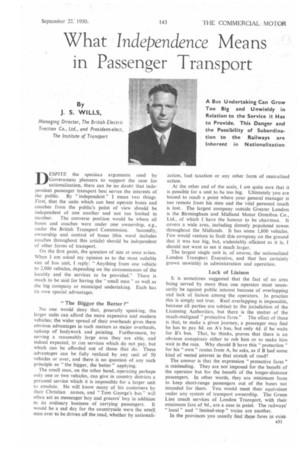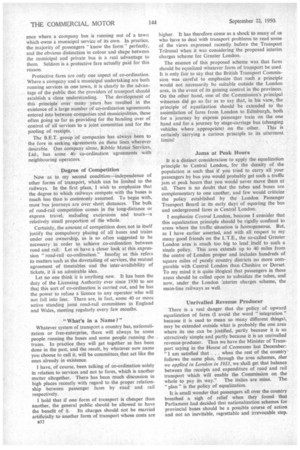What Independence Means
Page 65

Page 66

If you've noticed an error in this article please click here to report it so we can fix it.
in Passenger Transport
By J. S. WILLS,
Managing Director, The British Electric Traction Co., Ltd., and President-elect, The Institute of Transport DESPITE the specious arguments used by Governmeni planners to support the case for nationalization, there can be no doubt that independent passenger transport best serves the interests of the public. By independent " I mean two things. First, that the units which can best operate buses and coaches from the public's point of view should be independent of one another and not too limited in number. The converse position would be where all buses and coaches were under one ownership, e.g.,
under the British Transport Commission. Secondly, ownership and control of buses (this word includes coaches throughout this article) should be independent of other forms of transport.
On the first point, the question of size at once arises. When I am asked my opinion as to the most suitable size of bus unit, I reply: "Anything from one vehicle to 2,000 vehicles, depending on the circumstances of the locality and the services to be provided." There is much to be said for having the "small man" as well as the big company or municipal undertaking. Each has its own special advantages.
"The Bigger the Better ?"
No one would deny that, generally speaking, the larger units can afford the more expensive and modern vehicles; the wider spread of their overheads gives them obvious advantages in such matters as major overhauls, upkeep of bodywork and painting. Furthermore, by serving a reasonably large area they are able, and indeed expected, to run services which do not pay, but which can be afforded out of those that do: These advantages can be fully realized by any unit of 50 vehicles or over, and there is no question of any such principle as "the bigger, the better" applying.
The small man, on the 'other hand, operating perhaps only one or two vehicles, can give in country districts a personal service which it is impossible for a larger unit to emulate. He will know many of his customers by their Christian names, and "Tom George's bus" will often act as messenger boy and grocers' boy in addition to its ordinary business of carrying passengers. It would be a sad day for the countryside were the small man ever to be driven off the road, whether by nationali zation, fuel taxation or any other form of centralized action.
At the other end of the scale, I am quite sure that it is possible for a unit to be too big. Ultimately you are bound to reach a point where your general manager is too remote from his men and the vital personal touch is lost.. The largest company outside Greater London is the Birmingham and Midland Motor Omnibus Co., Ltd., of which I have the honour to be chairman. It covers a wide area, including densely populated towns throughout the Midlands It has some 1,800 vehicles. Few would venture to fault this company on the ground that it was too big, but, undeniably efficient as it is, I should not want to see it much lasger.
The largest single unit is. of course, the nationalized London Transport Executive, and that has certainly grown unwieldy in administration and operation.
Lack of Liaison It is sometimes suggested that the fact of an area being served by more than one operator must necessarily be against public interest because of overlapping and lack of liaison among the onerators. In practice this is simply not true. Real overlapping is impossible, because all parties are subject to the jurisdiction of the Licensing Authorities, but there is the matter of the much-maligned "protective fares." The effect of these is that, to make a given journey, a passenger may find he has to pay 8d. on A's bus, but only 4d. if he waits for B's bus. That, he thinks, proves that there is an obvious conspiracy either to rob him or to make him wait in the rain. Why should B have this " protection " for his " own " routes from A, he asks, as if B had some kind of vested interest in that stretch of road?
The answer is that the expression "protective fares" is misleading. They are not imposed for the benefit of the operator but for the benefit of the longer-distance passengers. In other words, they are minimum fares to keep short-range passengers out of the buses not intended for them. You would meet their equivalent tinder any system of transport ownership. The Green Line coach services of London Transport, with their minimum fare of 9d., are a case in point. The railways' " local " and " limited-stop " trains are another.
In the provinces you usually find these fares in exist831 ence where a company bus is running out of a town which owns a municipal service of its own. In practice, the majority of passengers "know the form perfectly, and the obvious distinction in colour and shape between the municipal and private bus is a real advantage to them. Seldom is a protective fare actually paid for this reason.
Protective fares are only one aspect of co-ordination. Where a company and a municipal undertaking are both running services in one town, it is clearly to the advantage of the public that the providers of transport should establish a close understanding. The development of this principle over many years has resulted in the existence of a large number of co-ordination agreements entered into between companies and municipalities, these often going so far as providing for the handing over of control of all services to a joint committee and for the pooling of receipts.
The B.E.T. group of companies has always been to the fore in seeking agreements on these lines wherever desirable. One company alone, Ribble Motor Services, Ltd., has some 40 co-ordination agreements with neighbouring operators.
Degree of Competition Now as to my 'second condition—independence of other forms of transport, which can be limited to the railways. In the first place, I wish to emphasize that the degree to which railways compete with the buses is much less than is commonly assumed. To begin with, most bus journeys are over short distances. The bulk of road-rail competition comes in the long-distance or express travel, including excursions and tours—a relatively small proportion of the whole.
Certainly, the amount of competition does, not in itself justify the compulsory placing of all buses and trains under one ownership, as is so often suggested to be necessary in order to achieve co-ordination between road and rail. Let us have a closer look at this expression "road-rail co-ordination." Insofar as this refers to matters such as the dovetailing of services, the mutual agreement of timetables and the inter-availability of tickets, it i an admirable idea.
Let no one think it is anything new. It has been the duty of the Licensing Authority ever since 1930 to see that this sort of co-ordination is carried out, and he has the power to refuse a licence to any operator who will not fall into line. There are, in fact, some 40 or more active standing joint road-rail committees in England and Wales, meeting regularly every few months.
"What's in a Name ?"
Whatever system of transport a country has, nationalization or free-enterprise, there will always be some people running the buses and some people running the trains. In practice they will get together as has been done in the past, and the result, by whatever new name you choose to call it, will be committees, that act like the ones already in existence.
I have, of course, been talking of co-ordination solely in relation to services and not to fares, which is another matter altogether. There has been much discussion in high places recently with regard to the proper relationship between passenger fares by road and rail respectively.
I hold that if one form of transport is cheaper than another, the general public should be allowed to have the benefit of it. Its charges should not be married artificially to another form of transport Whose costs are B32
higher. It has therefore come as a shock to many of us who have to deal with transport problems to read some of the views expressed recently before the Transport Tribunal when it was considering the proposed interim charges scheme for Greater London.
The essence of this proposed scheme was that fares should be equalized whatever form of transport be used. It is only fair to say that the British Transport Commission was careful to emphasize that such a principle would not necessarily be suitable outside the London area, in the event of its gaining control in the provinces. On the other hand, one of the Commission's principal witnesses did go so far as to say that, in his view, the principle of equalization should be extended to the assimilation of fares from London to Edinburgh, both for a journey by express passenger train on the one hand and for a journey by stage-carriage bus (changing vehicles where appropriate) on the other. This is certainly Carrying a curious principle to its uttermost limits!
Jams at Peak Hours It is a distinct consideration to apply the equalization principle to Central London, for the density of the population is such that if you tried to carry all your passengers by bus you would probably get such a traffic jam at peak hours that you would never move them at all. There is no doubt that the tubes and buses are complementary to one another, and few would criticize the policy established by the London Passenger. Transport Board in its early days of equating the bus and underground fares in Central London.
I emphasize Central London, because I consider that this equalization principle should be rigidly confined to areas where the traffic situation is homogeneous. But, as I have earlier asserted, and with all respect to my many good friends on the L.T.E., the so-called Greater London area is much too big to lend itself to such a single policy. This area extends up to 40 miles from the centre of London proper and includes hundreds of square miles of purely country districts no more comparable with Central London than Cheshire or Dorset. To my mind it is quite illogical that passengers in these areas should be called upon to subsidize the tubes, and now, under the London interim charges scheme, the main-line railways as well.
Unrivalled Revenue Producer There is a real danger that the policy of upward equalization of fares (I avoid the word " integration " because it is used to mean so many different things), may be extended outside what is probably the one area where its use can be justified, partly because it is so attractively simple and partly because it is an unrivalled revenue producer. Thus we have the Minister of Transport saying in the House of Commons last December: "I am satisfied that . . . when the rest of the country follows the same plan, through the area schemes, that we applied in London in 1933, we shall get that balance between the receipts and expenditure of road and rail transport which will enable the Commission on the whole to pay its way." The italics are mine. The " plan " is the policy of equalization.
It is small wonder that passengers all over the country breathed a sigh of relief when they found that Parliament had decided that nationalization schemes for provincial buses should be a possible course of action and not an inevitable, regrettable and irrevocable step.




































































































































































































































































